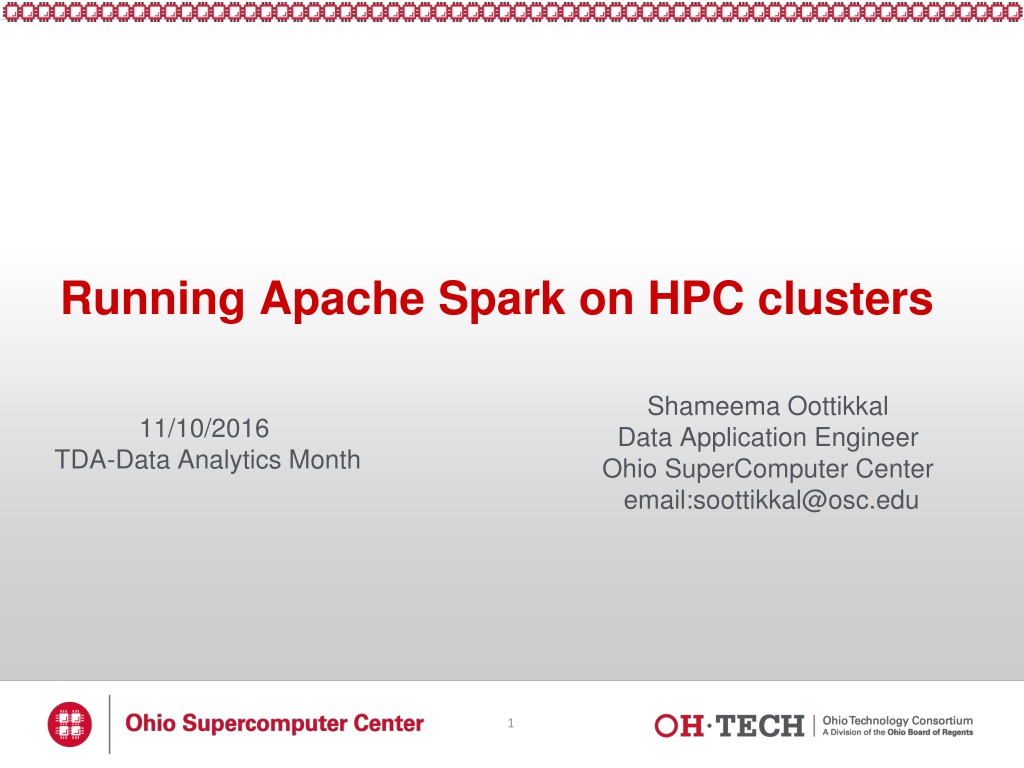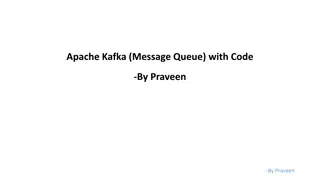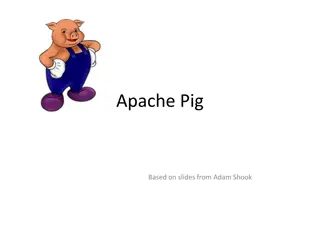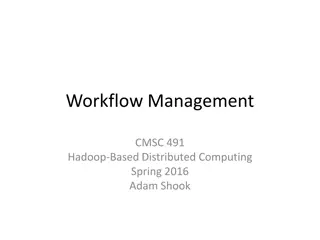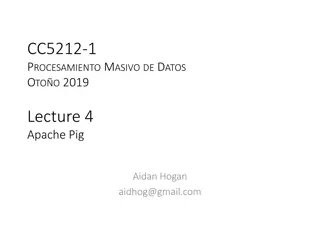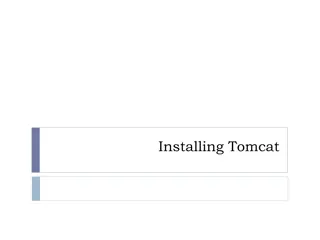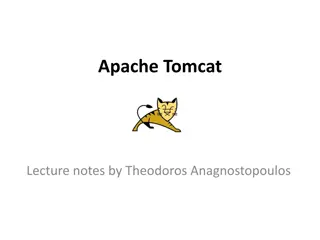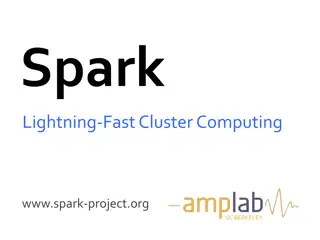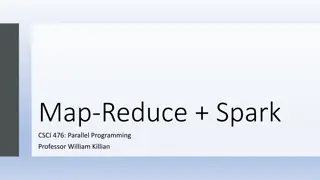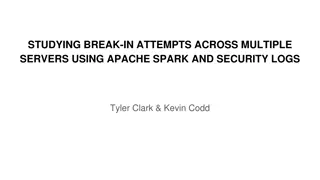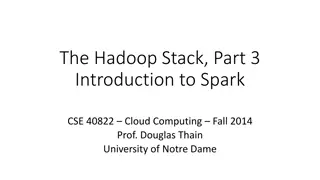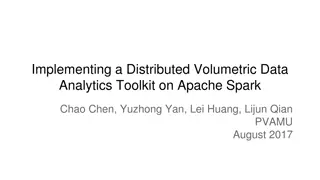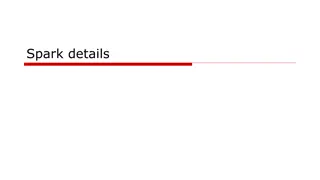Understanding Apache Spark: A Comprehensive Overview
Apache Spark is a powerful open-source cluster computing framework known for its in-memory analytics capabilities, contrasting Hadoop's disk-based paradigm. Spark applications run independently on clusters, coordinated by SparkContext. Resilient Distributed Datasets (RDDs) form the core of Spark's data processing model, allowing for transformations and actions on distributed collections of objects. The Spark ecosystem offers a range of tools and libraries for interactive analysis, with the Spark Shell providing a versatile environment for data processing tasks.
Download Presentation

Please find below an Image/Link to download the presentation.
The content on the website is provided AS IS for your information and personal use only. It may not be sold, licensed, or shared on other websites without obtaining consent from the author. Download presentation by click this link. If you encounter any issues during the download, it is possible that the publisher has removed the file from their server.
E N D
Presentation Transcript
Running Apache Spark on HPC clusters Shameema Oottikkal Data Application Engineer Ohio SuperComputer Center email:soottikkal@osc.edu 11/10/2016 TDA-Data Analytics Month 1
Apache Spark Apache Spark is an open source cluster computing framework originally developed in the AMPLab at University of California, Berkeley but was later donated to the Apache Software Foundation where it remains today. In contrast to Hadoop's disk-based analytics paradigm, Spark has multi-stage in-memory analytics. 2
Spark workflow Spark applications run as independent sets of processes on a cluster, coordinated by the SparkContext object in your main program (called the driver program). Require cluster managers which allocate resources across applications. Once connected, Spark acquires executors on nodes in the cluster, which are processes that run computations and store data for your application. Next, it sends your application code (defined by JAR or Python files passed to SparkContext) to the executors. Finally, SparkContext sends tasks to the executors to run. 5
RDD- Resilient Distributed Datasets RDD (Resilient Distributed Dataset) is main logical data unit in Spark. An RDD is distributed collection of objects. Distributed means, each RDD is divided into multiple partitions. Each of these partitions can reside in memory or stored on disk of different machines in a cluster. RDDs are immutable (Read Only) data structure. You can t change original RDD, but you can always transform it into different RDD with all changes you want. In Spark all work is expressed as creating new RDDs, transforming existing RDDs, or calling operations on RDDs to compute a result RDD- Transformations and Actions Transformations are executed on demand. That means they are computed lazily. Eg: filter, join, sort Actions return final results of RDD computations. Actions triggers execution using lineage graph to load the data into original RDD, carry out all intermediate transformations and return final results to Driver program or write it out to file system. Eg: collect(), count(), take() 6
Interactive Analysis with the Spark Shell ./bin/pyspark # Opens SparkContext 1. Create an RDD >>> textFile = sc.textFile("README.md") 2. Transformation of RDD >>>linesWithSpark = textFile.filter(lambda line: "Spark" in line) 3. Action on RDD >>> linesWithSpark.count() # Number of items in this RDD 126 4. Combining Transformation and Actions >>> textFile.filter(lambda line: "Spark" in line).count() # How many lines contain "Spark"? 15 Word count Example >>>wordCounts = textFile.flatMap(lambda line: line.split()).map(lambda word: (word,1)).reduceByKey(lambda a, b: a+b) >>> wordCounts.collect() [(u'and', 9), (u'A', 1), (u'webpage', 1), (u'README', 1), (u'Note', 1), (u'"local"', 1), (u'variable', 1), ...] 7
RDD Basics import urllib f = urllib.urlretrieve ("http://kdd.ics.uci.edu/databases/kddcup99/kddcup.data_10_percent.gz", "kddcup.data_10_percent.gz") data_file="./kddcup.data_10_percent.gz" raw_data=sc.textFile(data_file) normal_raw_data=raw_data.filter(lambda x: 'normal.' in x) normal_count=normal_raw_data.count() print ("There are %f 'normal' interactions" % (normal_count)) #predefined map functions def parse_interaction(line): elems = line.split(",") tag = elems[41] return (tag, elems) key_csv_data=raw_data.map(parse_interaction) 8
Running Spark using PBS script 1. Create an App in python: Stati.py from pyspark import SparkContext import urllib f = urllib.urlretrieve ("http://kdd.ics.uci.edu/databases/kddcup99/kddcup.data.gz","kddcup.data.gz") data_file = "./kddcup.data.gz" sc = SparkContext(appName="Stati") raw_data = sc.textFile(data_file) import numpy as np def parse_interaction(line): line_split = line.split(",") symbolic_indexes = [1,2,3,41] clean_line_split=[item for i, item in enumerate(line_split) if i not in symbolic_indexes] return np.array([float(x) for x in clean_line_split]) vector_data=raw_data.map(parse_interaction) from pyspark.mllib.stat import Statistics from math import sqrt summary = Statistics.colStats(vector_data) print ("Duration Statistics:") print (" Mean %f" % (round(summary.mean()[0],3))) print ("St. deviation : %f"%(round(sqrt(summary.variance()[0]),3))) print (" Max value: %f"%(round(summary.max()[0],3))) print (" Min value: %f"%(round(summary.min()[0],3))) 9
2. Create a PBS script: Stati.pbs #PBS -N spark-statistics #PBS -l nodes=18:ppn=28 #PBS -l walltime=00:10:00 module load spark/2.0.0 cd $TMPDIR pbs-spark-submit stati.py > stati.log 3. Run Spark job qsub stati.pbs 4. Output: stati.log sync from spark://n0381.ten.osc.edu:7077 starting org.apache.spark.deploy.master.Master, logging to /nfs/15/soottikkal/spark/kdd/spark-soottikkal- org.apache.spark.deploy.master.Master-1-n0381.ten.osc.edu.out failed to launch org.apache.spark.deploy.master.Master: full log in /nfs/15/soottikkal/spark/kdd/spark-soottikkal-org.apache.spark.deploy.master.Master-1-n0381.ten.osc.edu.out Duration Statistics: Mean 48.342000 St. deviation : 723.330000 Max value: 58329.000000 Min value: 0.000000 Total value count: 4898431.000000 Number of non-zero values: 118939.000000 SPARK_MASTER=spark://n0381.ten.osc.edu:7077 10
SparkSQL 1. Create App in python: sql.py from pyspark import SparkContext import urllib f = urllib.urlretrieve ("http://kdd.ics.uci.edu/databases/kddcup99/kddcup.data.gz","kddcup.data.gz") data_file = "./kddcup.data.gz" raw_data = sc.textFile(data_file).cache() #getting a data frame from pyspark.sql import SQLContext sqlContext = SQLContext(sc) from pyspark.sql import Row csv_data=raw_data.map(lambda l: l.split(",")) row_data=csv_data.map(lambda p: Row( duration=int(p[0]), protocal_type=p[1], service=p[2], flag=p[3], src_bytes=int(p[4]), dst_bytes=int(p[5]) ) ) interactions_df = sqlContext.createDataFrame(row_data) interactions_df.registerTempTable("interactions") # Select tcp network interactions with more than 1 second duration and no transfer from destination tcp_interactions = sqlContext.sql(""" SELECT duration, dst_bytes FROM interactions WHERE protocal_type = 'tcp' AND duration > 1.000 AND dst_bytes = 0 """) tcp_interactions.show() tcp_interactions_out = tcp_interactions.map(lambda p: "Duration: %f, Dest. bytes: %f"%(p.duration, p.dst_bytes)) for ti_out in tcp_interactions_out.collect(): print ti_out interactions_df.printSchema() interactions_df.select("protocal_type", "duration", "dst_bytes").groupBy("protocal_type").count().show() interactions_df.select("protocal_type", "duration", "dst_bytes").filter(interactions_df.duration>1000).filter(interactions_df.dst_bytes==0).groupBy("protocal_type").count().show() 11
CASE STUDY Data mining of historical jobs records of OSC s clusters Aim: To understand client utilizations of OSC recourses. Data: Historical records of every Job that ran on any OSC clusters that includes information's such as number of nodes, software, CPU time and timestamp. DATA on MYSQL DB Save as parquet file Import to Spark Data till 2016 Reload to Spark Analysis Newer Data Append to parquet file Import to Spark 13
Pyspark code #importing data df=sqlContext.read.parquet("/fs/scratch/pbsacct/Jobs.parquet") #Which types of queue is mostly used df_mysql.select("jobid",queue").groupBy("queue").count().show() #Which software is used most? from pyspark.sql.functions import df_mysql.select("jobid","sw_app").groupBy ("sw_app").count().sort(col("count").desc()) .show() #who uses gaussian software most? df_mysql.registerTempTable("mysql ) sqlContext.sql(" SELECT username FROM mysql WHERE sw_app='gaussian " ).show() 14
Results Statistics MYSQL SPARK Job vs CPU 1 hour 5 sec CPU vs Account 1.25 hour Walltime vs user 5 sec 5 sec 1.40 hour 15
References 1. Spark Programming Guide https://spark.apache.org/docs/2.0.0/programming-guide.html -Programming with Scala, Java and Python 2. Data Exploration with Spark http://www.cs.berkeley.edu/~rxin/ampcamp-ecnu/data-exploration-using-spark.html 3. Interactive Data Analytics in SparkR http://ampcamp.berkeley.edu/5/exercises/sparkr.html https://www.osc.edu/documentation/software_list/spark_documentation 16
